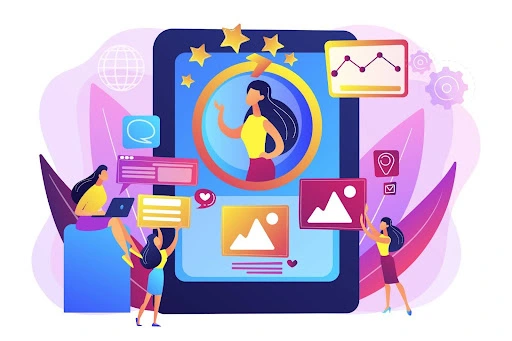
If you’ve scrolled through social media recently, chances are you’ve seen influencers recommending what to wear, where to travel, and most importantly, what to buy. Influencers have quickly become a collective force in digital marketing because they’re often seen as more reliable than other paid spokespeople.
With 33% of Gen Z and 28% of millennials making purchase decisions influenced by content creators, it’s clear influencers are reshaping how brands build customer loyalty and retention. Among them, micro-influencers do a better job of connecting brands with people, thanks to their smaller, more focused audiences.
In case you’ve been thinking about leveraging influencers for your brand, it’s time to look beyond the big names. Let’s explore how micro-influencers can make all the difference.
By definition, micro-influencers are social media users with a follower count ranging from 10,000 to 100,000. Even so, their smaller audiences are usually highly engaged and trust them more deeply.
These influencers often focus on niche topics—fitness, beauty, parenting, gaming, tech, or sustainable living, to name a few. Their specialized content creates a tight-knit community where trust is key. And that trust is why they’re so effective at building brand loyalty.
Micro-influencers interact with their audiences on a more personal level. They respond to comments, answer questions, and participate in conversations. With this level of engagement, their audience feels valued and tends to trust the influencer’s opinions.
When a micro-influencer promotes a brand, it doesn’t come off as a faceless sales pitch. Instead, it feels like a trusted friend sharing a recommendation. That’s a powerful way to create loyal customers.
Since micro-influencers often focus on specific topics, their audiences tend to have shared interests. In other words, they’re already primed for certain products and brands.
For example, if you’re a lifestyle company promoting clean beauty, partnering with a lifestyle micro-influencer in that space puts your product in front of people who are already interested in non-toxic, sustainable skincare.
When you collaborate with the right influencer, your message lands more effectively because it speaks directly to the needs and preferences of their audience, creating better results for your brand loyalty strategies.
Smaller audiences usually mean higher engagement rates. Micro-influencers typically see up to 60% more likes, comments, and shares on their posts than larger influencers do.
Numbers aside, high engagement is a sign that their followers are actively paying attention and valuing their recommendations. Eventually, it leads to real conversations about your product, deeper relationships with potential customers, and ultimately, stronger brand loyalty.
Depending on the industry you’re in, acquiring a new customer can cost five to seven times more than retaining an old one. That’s why influencer marketing for brand retention is so valuable.
Here’s how micro-influencers help brands turn one-time buyers into repeat customers.
People stick with brands they trust. When a micro-influencer recommends a product, it’s usually because they’ve tried it themselves. It doesn’t come across as a scripted ad or a forced promotion—it feels like advice from a friend.
That sense of authenticity strengthens customer confidence- meaning they’re more likely to come back and continue supporting your brand over time.
Micro-influencers know their audiences well and often customize their promotions to fit their followers’ preferences. A fitness influencer might show how your protein powder fits into their morning routine, or a mom blogger might explain how your eco-friendly diapers solved a real problem for their family. By showing real-life applications, micro-influencers help customers see exactly how your product fits into their own routines.
Unlike one-and-done ad campaigns that only grab attention for a short time, micro-influencers keep the conversation going. They post consistently throughout a campaign and create an ongoing dialogue about your brand. Consistent engagement keeps you visible and relevant- which is essential for retention.
Despite what many assume, there’s a strategic way to approach micro-influencer marketing to get real results.
Start by researching influencers in your niche. Look for those whose audience aligns with your target customers. Tools like Instagram’s search function, influencer marketing platforms, or even a simple hashtag search can help you find relevant creators.
Pay attention to their engagement rates, content style, and how they interact with their followers. The right influencer is someone who genuinely fits your brand’s voice and values.
Don’t just dive in with a sales pitch. Reach out and build a relationship with the influencer before making any requests. Follow them on social media, engage with their content, and show genuine interest in their work. When you finally approach them, they’ll already have a sense of who you are.
Brands looking for micro influencers should prioritize long-term relationships. While financial compensation is part of the deal, offering additional value can help you build stronger partnerships. Maybe it’s free products, early access to launches, or co-branded opportunities. Showing that you appreciate their work beyond the paycheck fosters better collaboration.
Let the influencer create content in their voice. Micromanaging their posts or trying to control the narrative too much can hurt their authenticity. Instead, provide guidelines about your brand’s values and let them bring your message to life in a way that resonates with their audience.
Micro-influencers often have a presence on multiple platforms like Instagram, TikTok, YouTube, and Twitter. If you’re working with an influencer, consider expanding the campaign across different channels for greater reach.
Say, a beauty influencer could create an Instagram Reel featuring your product, a YouTube review, and a TikTok tutorial. This multi-platform approach keeps your brand in front of potential customers in different ways, increasing engagement and conversions.
As more brands lean into micro-influencer marketing, it’s clear that working with these content creators isn’t just a trend—it’s a smart, sustainable way to grow.
If you’re ready to see how micro-influencers can transform your customer relationships, now’s the time to take action. Start small, build genuine partnerships, and watch as your brand loyalty and retention reach new heights.
Subscribe to our newsletter and get top Tech, Gaming & Streaming latest news, updates and amazing offers delivered directly in your inbox.